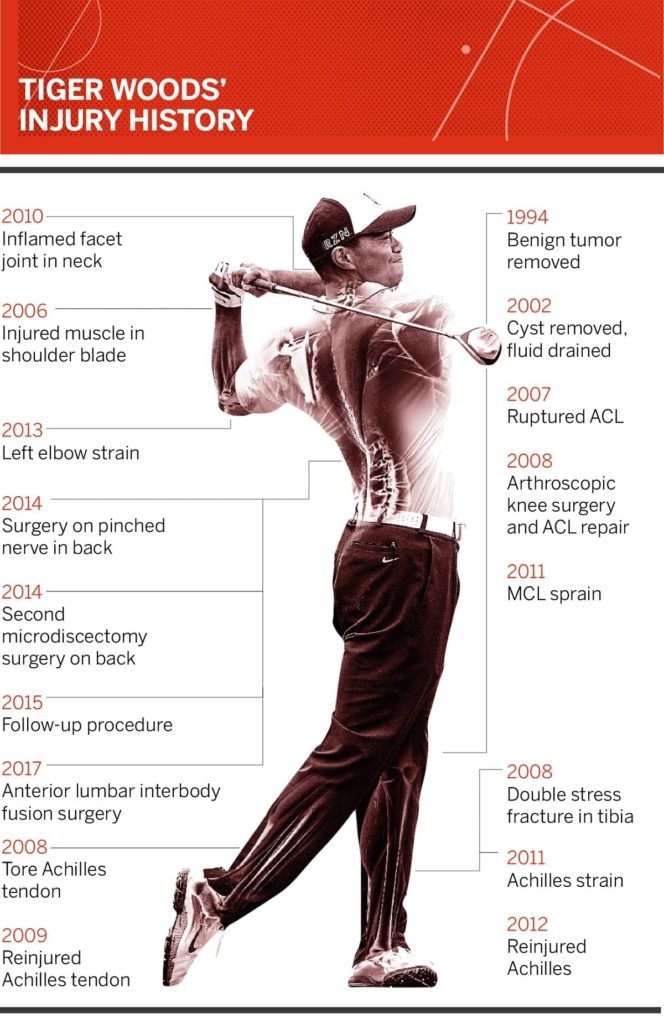Earlier this year, Bryson DeChambeau caused a stir when he returned to the PGA Tour with an additional 30 pounds of muscle on his frame. Along with his muscle gains came an impressive increase in the amount of power and speed to his golf swing.

In 2019, DeChambeau averaged 302.4 yards off the tee. As of 2020, current statistics sit at 337.8 yards. Bryson also has no shame posting social media videos of ball speeds in excess of 208mph, as well as drives in excess of 360 yards, numbers normally associated with World Long Drive Contestants.
Power Based on Science
It is no secret that Bryson DeChambeau is an exceptionally clever guy, basing everything he does on science. From his single plane swing, single length golf clubs, and recent experimentation with a 48 inch length driver, Bryson has always been an intriguing character.
Now, with his 7 PGA Tour titles and a US Open win, it seems he may have cracked the code to power and finesse on the course.
The Tiger Effect
24 years before DeChambeau made his staggering transformation, a young Tiger Woods introduced himself to the professional golfing world.
Armed with an aggressive long game and an immaculate short game, Tiger brought a new type of golf to the world. With Woods’ distance, golf courses began to “Tiger Proof” and started to grow increasingly longer.
With Tiger changing the golfing landscape and a massive increase in the money coming in through TV rights, sponsorships, and other sources, equipment also started to transform. Gone were persimmon drivers. Now, oversized woods and cavity backed irons were in. With the popularisation of this equipment, distance started to pick up for other golfers as well.
However, the length of golf courses and thickness of rough doesn’t necessarily seem to be affecting many of today’s golfers. A prime example is earlier this year at the US Open when Matthew Wolff carded a course-record tying 65 at Winged Foot, hitting only two fairways the entire round.
Golfers Are Now Athletes
Along with bringing more distance to golf, Tiger Woods was also the pioneer of golfers becoming more like athletes.
Not to say that golfers have always been overweight, but I certainly don’t remember golfers looking like Dustin Johnson, Brooks Koepka or Gary Woodland when I was growing up.

Over the last twenty four years, in search of perfection, Tiger continuously revamped his body and his swing. In his early years, he bulked up and added even more force to his already powerful game, creating an even more all rounded game in his latter years.
Are Strength and Power Shortening Golf Careers?
With professionals training much more like Olympians now, there also seems to be a notable increase in injuries.
In the ’70s, ’80s, and ’90s, bad backs seemed to be the most common injury. My suspicion is that these back injuries were caused from players contorting their bodies in an attempt to get the most out of wooden heads and unforgiving clubs.
Knee, hip, and back injuries continue to plague the tour, with players seemingly spending more time on the sidelines than on the links. The modern golf swing is one of such enormous torque, resistance, and explosivity that is is clearly taking a toll on today’s golf superstars.
Tiger Woods, regarded as the player responsible for transforming golf fitness, is a prime example of someone who has been repeatedly dogged by injuries over the last few years (see below). Although Tiger has continued to play, he was forced to significantly cut back on his playing schedule. At only 44 years old, it makes you wonder if other younger players will follow in his footsteps.

Technology in Golf
Modern technology is a hot topic in professional golf, with many calling for equipment to be dialed back. But would equipment modifications actually make a difference to the club golfer?
One could argue that, if anything, golfers are benefitting from today’s modern technology. Should something be done, or should we just let the pros fight it out?
What Does Next Golf’s Superstar Look Like?
Golfers still come in all shapes and sizes. We have already discussed Bryson DeChambeau and how muscle plays a pivotal part in his game.
There are also tall golfers such as Dustin Johnson, Tony Finau and Bubba Watson. Then there are golfers who are a little shorter and more flexible such as Justin Thomas, Xander Schauffle, Collin Morikawa, and Rory McIlroy. Jon Rahm is stocky and powerful and Brooks Koepka is a modern day golfing Super Man.
Will our next superstar be a hybrid of all these types of golfers? Is there room for World Long Drive contestants? Current World Champion Kyle Berkshire has already announced his intention to try get back into competitive golf… watch this space!



